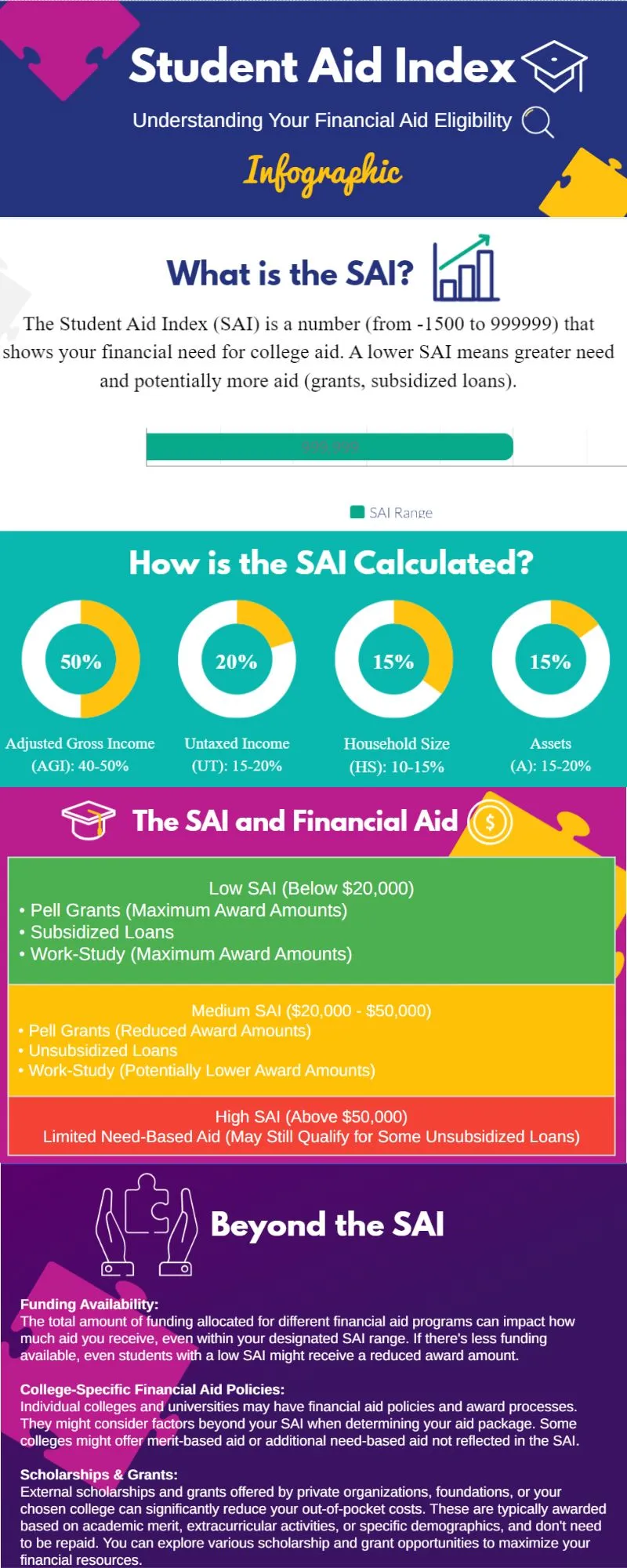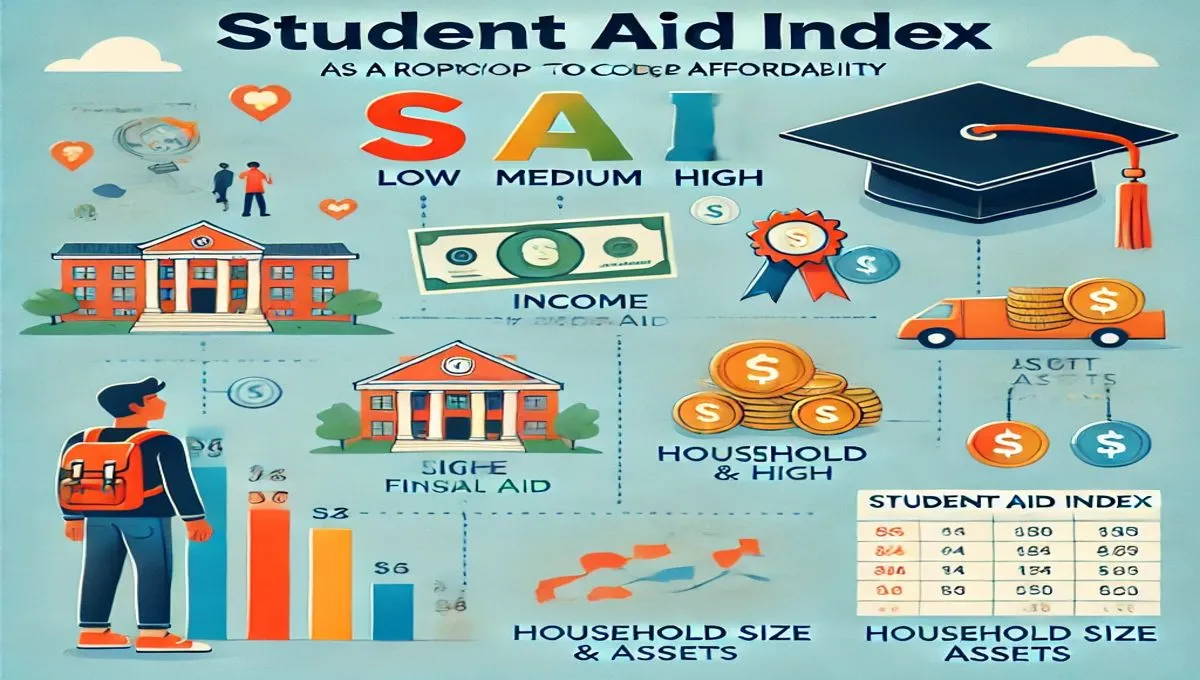For many students, starting college is both exciting and overwhelming. Financial aid, essential for making higher education affordable, can add complexity. It’s crucial to understand the details of financial aid programs and how to qualify for them. A key component is the Student Aid Index (SAI), introduced in the 2024-25 academic year, replacing the Expected Family Contribution (EFC).
This guide provides an in-depth look at the SAI and offers a clear roadmap for navigating financial aid. Whether you’re a high school senior, a transfer student, or a returning adult learner, understanding the SAI helps you make informed decisions about your college education.
What is the Student Aid Index (SAI)?
The Student Aid Index (SAI) is a standardized number ranging from -1500 to 999999, calculated by the federal government to assess a student’s (and their family’s) financial need for college. It determines eligibility for various federal student aid programs, including Pell Grants, subsidized loans, and work-study opportunities.
The transition from the EFC to the SAI marks a change in how need is assessed. While the details of the SAI calculation are confidential, it likely considers a broader range of financial factors compared to the EFC.
Key elements that influence your SAI:
- Adjusted Gross Income (AGI): Derived from your tax returns, reflecting your taxable income after certain deductions and adjustments.
- Untaxed Income: Sources of income not subject to federal taxes, such as Social Security benefits or certain investment income.
Household Size and College Attendance: The number of people in your household and the number of family members enrolled in college simultaneously. - Assets (Excluding Primary Residence and Retirement Savings): The value of your investments, savings accounts, and other assets, excluding your primary residence and retirement savings.
The SAI and Financial Aid: A Simplified Explanation
The core principle behind the SAI is straightforward: a lower SAI signifies greater financial need, potentially translating to more financial aid. Conversely, a higher SAI suggests a lower financial need and may limit eligibility for certain need-based programs.
| SAI Range | Financial Need | Potential Aid Eligibility |
| Low (Below $20,000) | Significant | Pell Grants, Subsidized Loans, Work-Study (maximum award amounts) |
| Medium ($20,000 – $50,000) | Moderate | Pell Grants (reduced award amounts), Unsubsidized Loans, Work-Study (potentially lower award amounts) |
| High (Above $50,000) | Lower | Limited Need-Based Aid (may still qualify for some unsubsidized loans) |
(Note: These ranges are estimates and may vary depending on specific circumstances.)

Beyond the SAI: A Holistic View of Financial Aid
While the SAI is crucial in determining your financial aid eligibility, it’s not the only factor. Additional considerations include:
- Funding Availability: The amount of funding allocated to different financial aid programs can impact how much aid you receive, even within your designated SAI range.
- College-Specific Financial Aid Policies: Individual colleges and universities may have their own financial aid policies and award processes. They might consider factors beyond your SAI when determining your aid package.
- Scholarships and Grants: Explore external scholarships and grants offered by private organizations, foundations, or your chosen college. These can significantly reduce your out-of-pocket costs.
Leveraging Your SAI for a Strategic College Journey
Understanding your SAI can empower you to make informed decisions throughout your college application process. Here are some ways to strategically use your SAI knowledge:
- Developing a College Budget: Knowing your estimated SAI allows you to create a realistic college budget. This helps you understand the potential gap between your financial aid award and total college costs, enabling you to strategize for financing the remaining amount.
- Exploring Scholarship and Grant Opportunities: Once you have an idea of your potential aid based on your SAI, you can explore additional scholarships and grants that can fill the financial gap. Utilize resources like scholarship search engines and your college’s financial aid office to find relevant opportunities.
- Negotiating Financial Aid Packages: Colleges often have some flexibility when it comes to financial aid packages. If your SAI doesn’t fully reflect your unique financial circumstances (e.g., high medical bills), you may be able to negotiate your aid package with the college’s financial aid office. Documenting any special circumstances can strengthen your case.
Resources for Your Financial Aid Journey
The road to college affordability is paved with resources. Here are some valuable ones:
- Federal Student Aid Website (https://studentaid.gov/): This official website from the U.S. Department of Education is a comprehensive one-stop shop for all things financial aid. It provides detailed information on the SAI, different types of financial aid programs, eligibility requirements, and the FAFSA application process.
- Free Application for Federal Student Aid (FAFSA) (https://studentaid.gov/): The FAFSA is the primary application form for federal student aid. Completing the FAFSA is crucial to determine your SAI and eligibility for various federal aid programs. The FAFSA website provides detailed instructions, resources, and a user-friendly online application platform.
- College Board BigFuture (https://bigfuture.collegeboard.org/): This free college planning resource from the College Board offers a wealth of information on financial aid, scholarships, and college affordability tools. You can use their financial aid calculators to estimate your SAI and potential aid eligibility based on different college choices.
- College Financial Aid Offices: Every college and university has a dedicated financial aid office. Don’t hesitate to reach out to them with questions or concerns regarding your financial aid package. They can provide personalized guidance and assistance specific to your college and financial situation.
Additional Tips for Maximizing Your Financial Aid
By following these helpful tips, you can enhance your chances of receiving a generous financial aid package:
- Start Early: The earlier you start researching and applying for financial aid, the more time you have to explore all available options and meet deadlines.
- Complete the FAFSA Accurately: Ensure you provide accurate information on the FAFSA to qualify for the maximum amount of aid you deserve.
- Meet Deadlines: Financial aid deadlines vary by program and institution. Missing deadlines can significantly impact your eligibility for aid.
- Consider All Options: Explore various financial aid programs, scholarships, grants, and work-study opportunities to maximize your financial resources.
- Research College-Specific Aid: Learn about the specific financial aid policies and scholarships offered by your target colleges. Some colleges offer merit-based aid or additional need-based aid not reflected in the SAI.
Embracing Transparency and Collaboration
Open communication with your parents or guardians is crucial when navigating the financial aid process. Discuss your college aspirations and financial situation honestly. Working together, you can create a realistic financial plan for your education.
The path to college affordability is rarely linear. Remember, you don’t have to navigate the financial aid labyrinth alone. Utilize the resources provided, seek guidance from financial aid offices, and reach out to counselors or mentors for support. By understanding the Student Aid Index and leveraging it strategically, you can unlock opportunities and pave the way for a brighter academic future.
